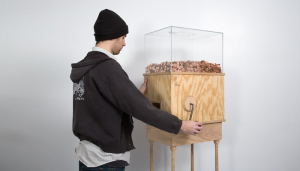
BY ROBERT PAGLIARINI
You can simplify your life and even avoid information pornography, but if you’re like most people, your email inbox is still bursting at the seams, your voice mail is full, and you’re getting slammed with too much stuff.
To make matters worse, you get flooded with old-fashioned mail. It’s a cause of real stress and anxiety. Why? In the wise words of Newmanfrom Seinfeld: “Because the mail never stops. It just keeps coming and coming and coming, there’s never a let-up. It’s relentless. Every day it piles up more and more and more!” [Watch this clip on YouTube]
To avoid going Newman, er, I mean postal, you need an effective system to capture and process your mail quickly. The key to any system is to make sure it works when life is calm but also when you are crazed and have a hundred things going on at once.
If you follow these four steps, you will be able to control your mail once and for all. It might seem like a lot of work initially, but once you set this up, it will run smoothly and effortlessly.
Step 1 – Dump
You’ll need one big bin labeled “Unsorted Inbox.” Whenever you get the mail, you can dump it all into this bin, or if you have some time, you can skip directly to the “Sorting” step below.
Step 2 – Sort
If there are multiple people in your house that receive mail, you will still need an Unsorted Inbox bin, but you’ll also need a separate inbox tray for each person. For example, if you’re married and have two high school children, you would need one inbox bin and four trays-one for each family member. Each of the trays should be marked with a family member’s name (e.g., Robert’s Inbox, Mary’s Inbox).
If Junior grabs the mail as he’s heading out to football practice, he can throw everything into the Unsorted Inbox. Then when mom comes home and has a few extra minutes, she can take everything out of the Unsorted Inbox and sort it (i.e., go through each piece of mail and dispense it to the correct inbox.
Step 3 – Screen
Screening is the process of going through your inbox and separating the important mail from the not-so-important and putting it into the following three trays/folders/baskets:
– Magazines/Catalogs
– “Junk” Mail to Shred (junk mail that doesn’t need to be shredded can be tossed immediately during this step)
– Everything Else
If there are multiple people at your house, ideally each person would not only have their own inbox but they would also have their own three screening trays. I like the idea of making the inboxes portable so you can pick up your inbox and take it with you to the den, bedroom, office, etc. and Screen/Process on your own turf. Plus, you won’t have 100 bins/trays clogging up your kitchen.
Step 4 – Process
Once your mail has been screened, you then need to process it. Processing your mail involves opening it and determining what the next action is:
Magazines/Catalogs – No rush to do anything here. You can let these pile up, and then when you have down time, you can go through them. If you’re heading to the doctor, dentist, or getting your oil changed, grab a handful of magazines/catalogs to take with you while you wait.
“Junk” Mail to Shred – The action here is to shred this stuff. Keep a shredder nearby so you can quickly and easily get rid of this mail.
Everything Else – This is the meat of your mail. When you go through the Everything Else tray, you’ll probably throw some things away that may have looked important but was actually junk mail. But for most of the contents in the Everything Else tray, there will be some action to take such as pay a bill, read a letter, review a bank statement, etc.
You can either do whatever action is required right then, or you can put mail with like actions in the same folder. For example, you can create a “Pay Bills” folder and put all of your bills in it. Twice a month you can grab all the bills from this folder and pay them. Or you can have a “Statements Review” folder where you would put all of your bank and investment account statements you want to review at some later point.
The number of action folders is really up to you. Start with a few basics such as “Pay Bills” and “Statements Review.” If you discover there is another recurring action, you can then create a folder for it.
You can’t stop the mail (just ask Kramer), but you can certainly manage it. But what about all of the other documents and information in your life? I’m glad you asked. I’m working on a series that will help you take back control of your life and all the stuff in it. Because when you aren’t drowning in information and mail, you can spend more of your other 8 hours writing books, becoming a better public speaker,investing in yourself, learning, and creating.
















